What woodpeckers can you see in Italy? There are 8 different species of woodpecker that you might encounter in Italy. Read this article to see pictures, hear their sound and get great information about where and when you can spot all woodpeckers in Italy.
In Italy, a land where the past meets the present, where art, culture, and cuisine harmonize like the notes of a timeless melody, there’s another symphony unfolding—one that’s played out in nature. Amidst olive groves, vineyards, and ancient ruins, Italy boasts a rich avian tapestry, with woodpeckers acting as the percussionists. Let’s embark on a journey to discover Italy’s woodpeckers, starting with the elusive Eurasian Three-toed Woodpecker.
Let’s jump into the article.
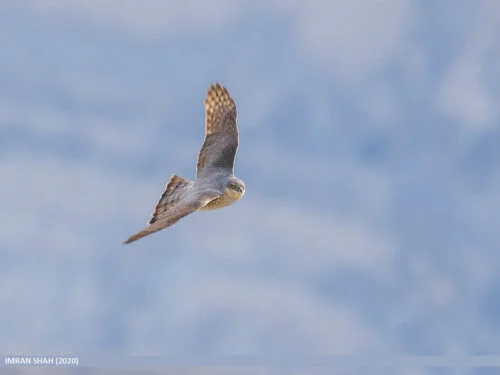
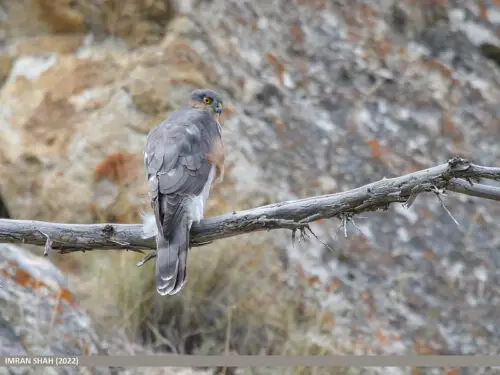
The Eurasian Three-toed Woodpecker – unlike its four-toed cousins, this unique bird showcases a trio of toes, a characteristic from which it derives its name.
Adorning a primarily black and white ensemble, the Eurasian Three-toed Woodpecker exhibits an understated elegance. Males can be identified by their yellow cap, a contrast to the snowy landscapes they often inhabit.
The Alpine and Apennine regions of Italy, with their coniferous forests, provide an ideal setting for this bird. It’s especially fond of areas affected by disturbances like forest fires or pest outbreaks, which offer a buffet of insect larvae, its primary diet.
While it’s a skilled drummer, the drumming of the Eurasian Three-toed is more sporadic and less forceful than that of other woodpeckers. Instead, it’s their call—a sharp “kik-kik-kik”—that often gives away their presence.
In Italian folklore, the quiet presence of this bird amidst snowy landscapes is seen as a symbol of resilience and hope. Some tales even suggest that spotting one can bring good luck.
For those journeying through Italy’s mountainous terrains, encountering the Eurasian Three-toed Woodpecker is like finding a hidden gem—a subtle, serene experience that beautifully complements the grandeur and passion of the Italian landscape.
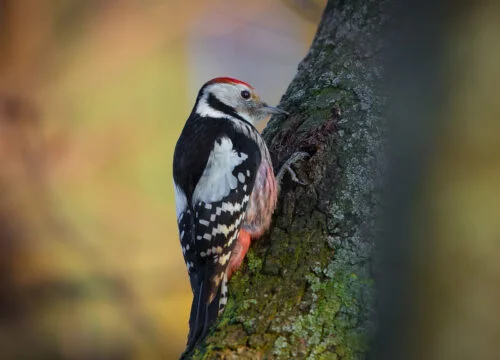
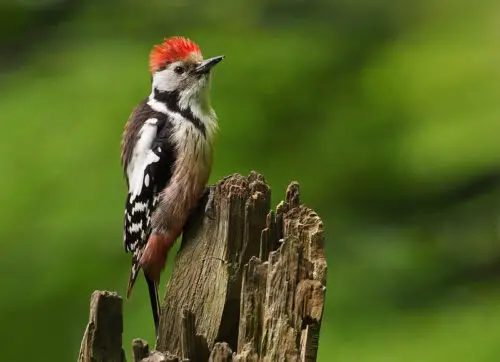
Among the many wonders Italy offers, from the entrancing song of the gondolier to the aroma of freshly baked focaccia, there’s a hidden rhythm that resonates deep within its woods. This rhythm belongs to the Middle Spotted Woodpecker, a bird as vibrant and spirited as an Italian carnival.
With its playful polka-dotted plumage, the Middle Spotted Woodpecker is a sight to behold. It’s smaller than some of its woodpecker relatives but makes up for its size with its striking appearance. The bird wears a bold crimson cap, and its white underparts are punctuated with streaks of black, making it resemble a masterful piece of Italian art.
Italy’s deciduous and mixed forests, especially in regions such as Tuscany and Umbria, are where this lively bird prefers to set up residence. Oak trees, in particular, are its favorite, offering both shelter and a rich menu of insects, larvae, and occasionally, fruits.
Unlike many of its relatives, the Middle Spotted Woodpecker doesn’t drum frequently. Instead, its presence is often announced by its sharp, repeated call that resonates through the forest.
Local tales often reference this bird as a painter of the woods, its pecking akin to an artist dabbing a canvas, creating nature’s masterpiece. Some stories even equate its rhythmic pecking to the heartbeats of the forest, emphasizing its integral role in the woodland ecosystem.
Visitors strolling through the dense coppices or sipping on their Chianti under the canopy might be lucky enough to catch a glimpse of this avian wonder. In the embrace of the Italian landscape, the Middle Spotted Woodpecker stands as a testament to the beauty and rhythm that nature and culture, together, can orchestrate.
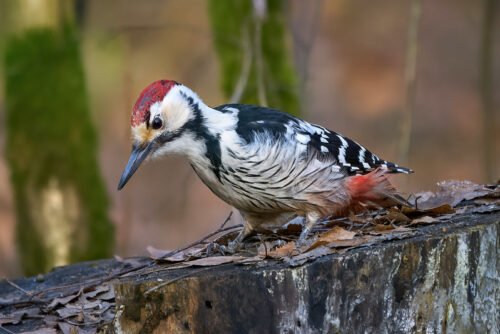
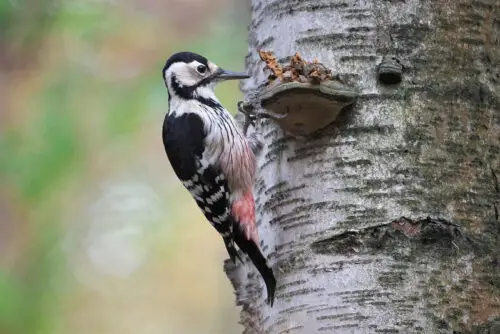
The White-backed Woodpecker, often likened to an elusive artist, this bird paints its story in the secluded woodlands of Italy.
Donning a sleek white back that stands in stark contrast to its black wings and tail, the White-backed Woodpecker exhibits a minimalist elegance that would make even the finest Italian designers nod in approval. Males add a touch of drama with a red crown, while the females opt for a subtler headgear.
The ancient, primeval forests of Northern Italy, particularly in regions like Lombardy and the Dolomites, provide a sanctuary for this woodpecker. These woodlands, with their mature deciduous trees and deadwood, present an ideal backdrop for the bird’s daily pursuits, which largely involve hunting for beetles and other insects.
Despite its striking appearance, the White-backed Woodpecker remains one of the more elusive woodpeckers. Its soft, muffled drumming and occasional “kweek” calls often serve as the only hints of its hidden presence in the dense woods.
In Italian folklore, this bird is often associated with mystery and magic. Old tales speak of the White-backed Woodpecker as a forest spirit that watches over the trees, ensuring their well-being.
For those embarking on a nature-centric sojourn in Italy, the mere chance of spotting this elegant woodpecker amidst the mosaic of green is truly special. The White-backed Woodpecker, with its quiet grace, embodies the soulful, timeless beauty that Italy, in all its facets, exudes.
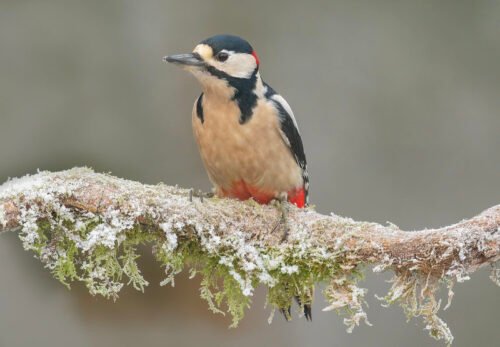
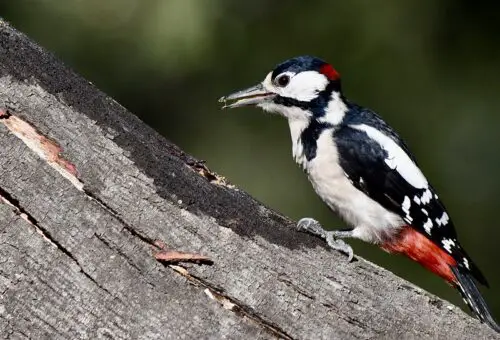
The Great Spotted Woodpecker, as iconic to Italian woodlands as the cypress trees that stand sentinel over its countryside.
Easily one of the most recognizable woodpeckers, the Great Spotted Woodpecker boasts a striking black-and-white pattern, making it look like it’s dressed in a dapper tuxedo for a night at the opera. The male carries a distinctive red patch on the nape, while both genders display vivid red undertail coverts, adding flair to their ensemble.
Found across Italy, from the alpine woods in the north to the oak-rich forests in the south, this woodpecker has a penchant for a variety of trees, though it’s particularly fond of pines and beeches. Within these trees, it carves out its existence, drilling into the bark in search of insects, larvae, and the occasional sap treat.
The rhythmic drumming of the Great Spotted Woodpecker is often the forest’s metronome, setting the pace for other avian melodies. This drumming, combined with its sharp, resonant call, often heralds its presence long before one can catch a glimpse of it flitting between branches.
In Italian tales, this bird symbolizes persistence and determination. Legends narrate stories of the woodpecker’s relentless quest for sustenance, drawing parallels with the human spirit’s undying pursuit of passion and dreams.
For travelers and nature enthusiasts exploring Italy’s vast landscapes, the song and sight of the Great Spotted Woodpecker serve as reminders of the intricate dance between nature and culture in this beautiful land. As you sip your espresso or relish a gelato under the shade, keep an ear out for the drumming, for it’s Italy’s way of sharing its wild, beating heart.
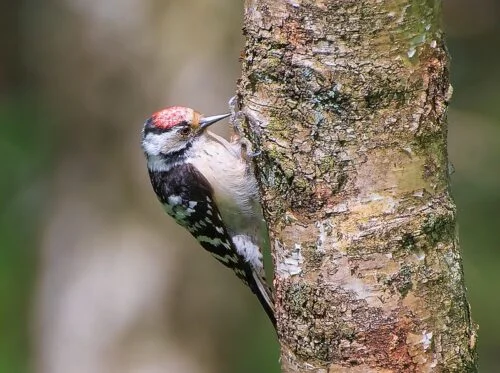
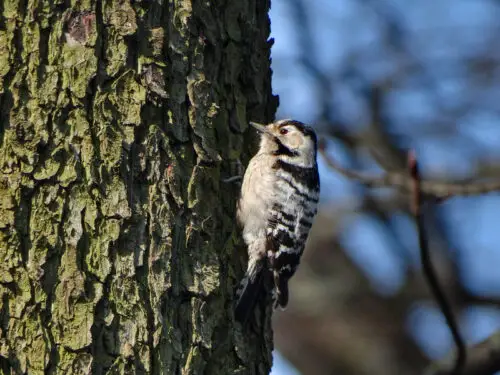
The Lesser Spotted Woodpecker, a diminutive drummer that, though small in stature, leaves a lasting impression on those fortunate enough to encounter it.
This petite woodpecker, almost the size of a sparrow, is cloaked in a delicate palette of black, white, and soft red. Males wear a modest red crown, setting them apart from the females. But what it lacks in size, the Lesser Spotted Woodpecker more than makes up for in vibrancy and spirit.
Throughout Italy, from the deciduous woods of Emilia-Romagna to the lush forests of Abruzzo, this woodpecker flits and flies, often high up in the tree canopy. Preferring older trees with plenty of deadwood, it meticulously searches for insects, particularly wood-boring beetles, which constitute its primary diet.
Its drumming is soft, almost like a gentle tap on a door, in contrast to the louder beats of its larger relatives. The bird’s call—a high-pitched, repeated “kee-kee-kee”—often betrays its presence, making it easier for keen birdwatchers to spot.
In local Italian lore, the Lesser Spotted Woodpecker, due to its small size and persistent nature, symbolizes the importance of humility and hard work. Tales often speak of the bird’s tenacity, reminding listeners that no task is too big if one’s heart and spirit are in the right place.
As you traverse Italy’s diverse landscapes, from its bustling cities to its serene countryside, keep a watchful eye and an attentive ear out. The Lesser Spotted Woodpecker’s presence, though understated, encapsulates the essence of Italy—a blend of grandeur and simplicity, history and nature, passion and tranquility.
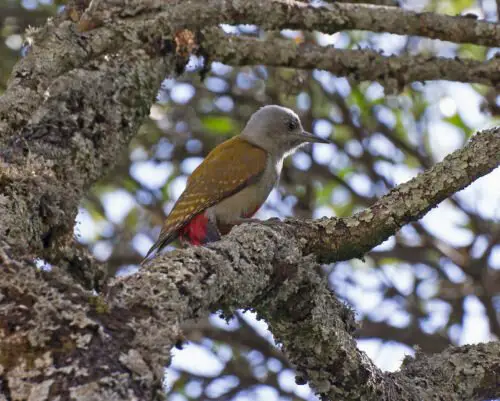
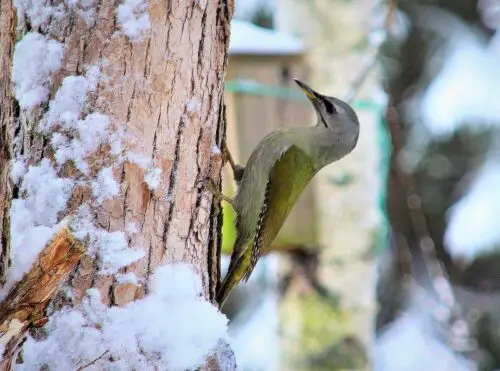
The Grey-headed Woodpecker brings a quiet charm to the Italian countryside that can captivate any nature lover.
Dressed in soft hues of grey and green, the Grey-headed Woodpecker is a study in elegance. Its muted grey head and greenish body stand in beautiful contrast to the fiery red crown of the males, offering a visage that seems tailor-made for the gentle landscapes of Italy. The females, in their restraint, forego the red and embrace an all-grey head, exuding a subdued grace.
Favoring broad-leaved forests and well-wooded areas, this woodpecker is particularly drawn to the older, deciduous forests in regions like Lombardy and Piedmont. Its diet is a diverse platter of insects, seeds, and occasionally fruits. The rhythmic tapping of its beak as it forages offers a subtle, almost musical backdrop to the Italian forest soundscape.
Unlike its more flamboyant cousins, the Grey-headed Woodpecker is less about drumming and more about its voice—a series of sharp, mellow calls that can both intrigue and mystify listeners.
Italian folklore, rich with tales of valor and romance, occasionally touches upon the steadfast nature of the Grey-headed Woodpecker. It’s seen as a symbol of persistence, with stories often emphasizing the bird’s dedication to its craft and home.
For the traveler savoring the delights of Italy, from its art to its cuisine, the chance encounter with a Grey-headed Woodpecker can be an unforgettable experience. It reminds one that amidst all the grandeur and spectacle, there’s a quieter, gentler Italy that beats in the heart of its woods and meadows.
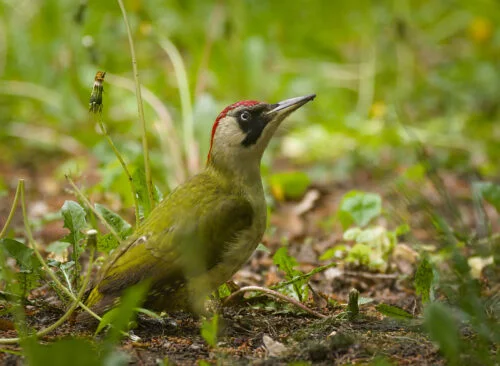
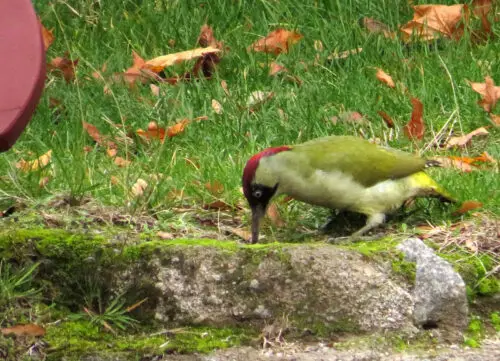
The Eurasian Green Woodpecker is draped in a rich olive-green, this woodpecker is the embodiment of the verdant Italian countryside. It sports a distinctive red crown and black moustache-like markings on its face, which give it an appearance of aristocracy—a bird that would fit right into the courts of ancient Roman emperors. The loud, laughing “yaffle” call of this bird has echoed through Italian woodlands for centuries, adding a unique voice to the symphony of nature.
The Eurasian Green Woodpecker is quite the cosmopolitan, making its presence felt from the foothills of the Alps to the oak-laden woods of Tuscany. Unlike its wood-pecking brethren, this bird has a particular fondness for ants. It can often be spotted on the ground, using its long, sticky tongue to feast on anthills—a gourmet delight in the avian world.
Its drumming, a softer, more rhythmic roll, is less frequent than its more flamboyant counterparts but carries a unique cadence that resonates with the heartbeats of the forests.
Italian tales, with their propensity for passion and drama, often draw parallels between the vivacity of the Eurasian Green Woodpecker and the spirit of adventure. The bird is seen as a guardian of the woods, a symbol of nature’s undying vibrancy in a land steeped in history and art.
As you journey through Italy, savoring its architecture, culture, and food, let the laughter of the Eurasian Green Woodpecker be your guide to the wild, untouched corners of this magnificent land. After all, Italy isn’t just about history; it’s also a tale of nature’s timeless allure.
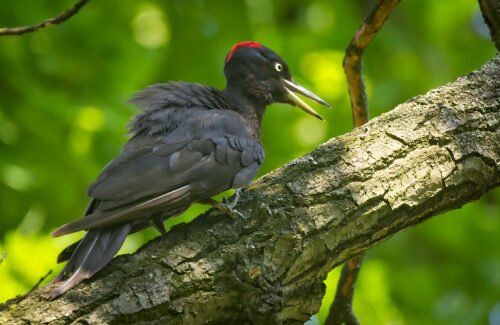
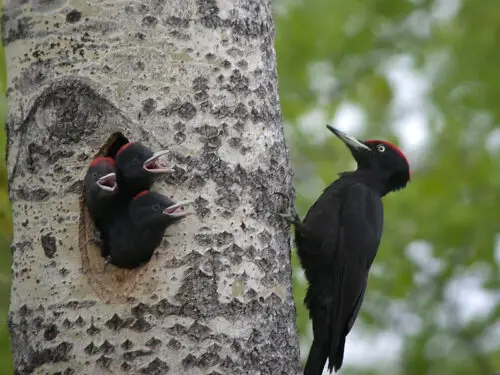
The Black Woodpecker seems like a creature plucked from a fable, it adds a touch of mystique to the Italian wilderness, narrating tales of old in its distinct and echoing drum.
With its almost entirely glossy black plumage and contrasting vibrant red crown (more pronounced in males), the Black Woodpecker is the very embodiment of elegance and intrigue. It is the largest of Europe’s woodpeckers and carries itself with a demeanor befitting its size. Its deep, resonant drumming is a sound that once heard, isn’t easily forgotten, reverberating through the pine and beech forests it calls home.
In Italy, from the dense woodlands of the Dolomites to the serene groves of Umbria, this woodpecker is both a sight and sound to behold. Its diet largely consists of wood-boring insects, but it’s also known to enjoy a mix of fruits and nuts, representing the varied and rich gastronomy of Italy in its own unique way.
The Black Woodpecker’s call—a series of loud, sharp notes—often serves as an alarm in the forest, alerting other creatures to potential threats or simply announcing its presence with pride.
In Italian folklore, the Black Woodpecker is often associated with mystery and magic. Its dark appearance and deep calls have inspired tales of it being a guardian of the forest, a wise old bird that holds the secrets of the wilderness.
As one explores the romantic lanes of Italy, with its art, history, and unparalleled landscapes, the Black Woodpecker serves as a reminder of nature’s darker, more enigmatic side. It beckons travelers to venture deeper into the woods, to discover the untold stories and unsung heroes of Italy’s vibrant ecosystems.





